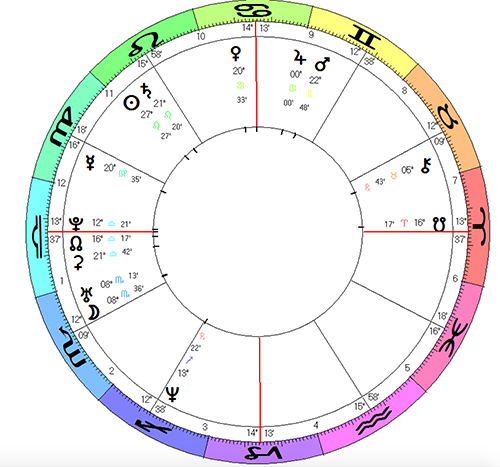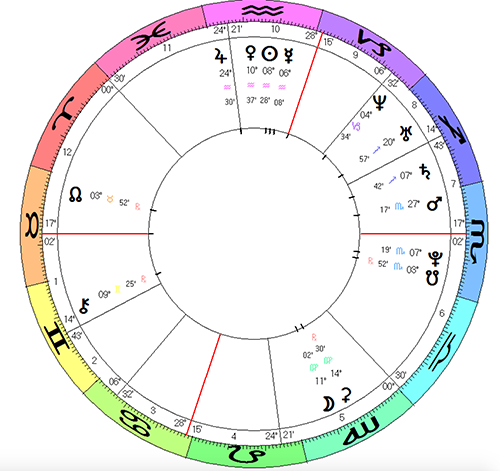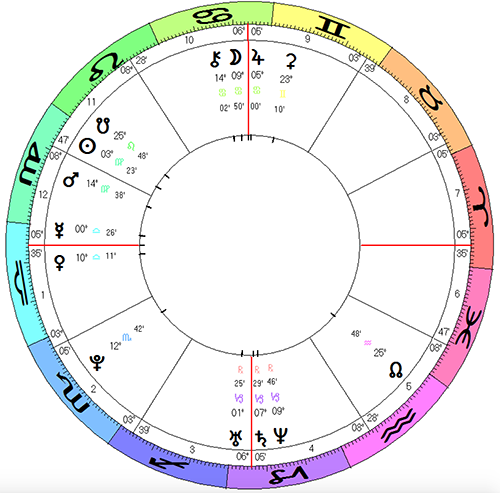On Planet Earth, we revolve on our axis at 1000 mph, traveling around the Sun at 67,000 mph, whilst the Sun is traveling around the center of the Milky Way at a speed of 450,000 mph. Everything is revolving and spiraling through space, generating enormous gravitational and magnetic forces.
On Earth, we feel sheltered from these forces, wrapped up in the paper-thin cocoon of our oxygenated atmosphere, anchored on the even thinner crust of the Earth, which encases the molten center of the planet. Astronomy is the science which reveals these, our physical circumstances. Astrology is the art which shows how humans and the cosmos interact in this maelstrom of known and unknown forces.
The Heliosphere
In its travels, spiraling around the Sun through the Milky Way, Earth forges through thousands of tons of cosmic particles, of which tens of tons fall to the Earth each day as cosmic dust. The Sun itself, carries in its gravitational field an ecosystem of planets, comets, asteroids and moons, in what is known as the heliosphere – the Sun’s domain. When the heliosphere hits interstellar space Termination Shock is reached, which is when the solar wind can no longer compete against interstellar forces, and turns in on itself.
We know all this, because the spacecraft Voyager 1 left the heliosphere on August 25th, 2012. Meanwhile, its sister ship Voyager 2 is, here in 2018, also leaving the heliosphere, 40 years after its launch, carrying with it a Golden Record with digitally recorded music, pictures of human existence on Earth and other relevant information, so that – some time in the distant future – an alien species will know we are here. From India, the message was: “Hello to everyone. We are happy here, and you be happy there”.
The Launch
This article tells the story of mankind’s longest journey. In the summer of 1977 both Voyager spacecraft were launched – first Voyager 2, then some weeks later, Voyager 1. For this journey to take place, launch could only take place at this time in history – not before. Why? Because Jupiter, Saturn, Uranus and Neptune had to be in alignment, and for that to take place, Jupiter has to be approaching Saturn, Saturn has to approach Uranus, and Uranus has to approach Neptune (which can only happen once ever 172 years). The whole point of this alignment for the Voyager program was that close flybys gave “gravity assist” accelerating the speed of the spacecraft to over one million miles a day and cutting over 20 years from travel time.
Thus, by an extraordinary stroke of “luck” Voyager could fly by all major planets (except Pluto) exactly at the time mankind had the technological capacity to do so.

Voyager 2 launch. August 20, 1977, 21.26 Cape Canaveral, Florida AS 13.38 Libra
The plan was to send Voyager 1 to Jupiter and Saturn and on a flyby of Saturn’s largest moon Titan, and from there off out of the heliosphere. Voyager 2 was to go to Jupiter and Saturn, and if all went well, on to Uranus and Neptune. In the mid-seventies computers were in their infancy. No flash drives, no hard disks – data was recorded on a tape recorder, and the calculations to time arrivals at each planet and turn the camera on the spacecraft to photograph each moon at an exact hour were extremely complex. For the mechanics to work there was a plutonium energy source which gave enough warmth to prevent breakdown in near absolute zero temperatures.
Voyager 2 horoscope
Perhaps all this can be seen in the launch horoscope, where Pluto conjoins the Ascendant (the plutonium?) and the North Node of the Moon. At the same time, the Moon in Scorpio exactly conjoins Uranus which is an extraordinarily explosive combination – something which was to be discovered in an unexpected way when Voyager 2 flew past Uranus. The Sun configures exactly with Moon/Uranus by quintile aspect (and Neptune/Venus by semi-quintile), and septile aspects – the 7th harmonic horoscope – show an amazing conjunction of Jupiter and Saturn with the Pluto/Ascendant and opposing Moon/Uranus on the Descendant. In other words, all the planets beyond Mars are configured in a tight pattern reflecting the qualities of 5, creative outreach, and 7, cosmic mystery.
What better signature for the Voyager Grand Tour than to see Jupiter itself just entering exaltation in Cancer at 0.00 degrees – a key degree for world events. together with Mars in the 9th house. Mars itself is square Mercury, symbolizing perhaps the transmission back to Earth of an unprecedented amount of data, and never-before seen images of the moons of Jupiter, Saturn, Uranus and Neptune. To crown the magic of this horoscope, Venus in Cancer is exactly sextile Mercury with an orb of 2 minutes of arc, reflecting, perhaps, the extraordinary beauty and detail of the digital photography.
Discovery of the Outer Planets
The discovery of Uranus, Neptune and Pluto in 1781, 1846 and 1930 respectively, clearly showed that outer exploration was synchronistic with transformative changes in society. The development of the telescope enable the discovery of Uranus, which at a stroke doubled the area of the solar system. This was the time when revolutions shook first the USA in 1776 and then France in 1789. The principles of freedom, equality and brotherhood were enshrined in constitutions in true Aquarian fashion. Mankind conquered the air, first with hot air balloons, later with jet aircraft and rockets. The discovery of Neptune coincided with the first use of anesthetics, the communist manifesto, and the development of the camera, which later found expression in film and the cinema. And the discovery of Pluto coincided with the Depression, dictatorial leadership, the splitting of the atom and later the threat of world destruction with the atomic bomb.
The same synchronicity affects every human exploration of our solar system. Pictures sent back by the Apollo spacecraft of the Earth rising over the horizon of the Moon, became the first cosmic Selfie. The first Earth Day in 1970 was inspired by this Apollo 8 Earthrise photo. It awakened ecological consciousness, and the Moon landing awakened a nurturing awareness of the vulnerability of our planet and, interestingly, attachment theory (Moon) became a predominant development in psychology. By the mid-1970’s spacecraft had made flybys of Venus (1962), Mercury, and landed a rover on Mars. The Pioneer 11 spacecraft had even flown by Jupiter and in 1979 Saturn, but they were unable to send back pictures of better quality than those acquired by telescopes on Earth.
The Euphoric Arrival at Jupiter
The Voyager Grand Tour opened a new dimension. In 1979 both Voyagers arrived at Jupiter sending a stream of fantastic pictures, and showing that water and volcanic activity existed on some of the moons, particularly Europa, which made them candidates for habitation. Voyager 1 arrived on March 5th, 1979 and Voyager 2 on July 9th, 1979. Back on Earth, this was the time the Islamic Republic of Iran was founded, with the return of Ayatollah Khomeini, which sparked decades of religious fundamentalism, as Middle-Eastern countries competed to be leaders in the Islamic world. With the election of Margaret Thatcher that year, another kind of idealism – Thatcherism – was to take hold. This was the theory of expansion without excessive state control – a philosophy which also took hold in the USA with the election of Reagan in 1980 and Reaganomics. In China, Deng Xiaoping introduced “Socialism with Chinese characteristics”, which gave rise to a burst of capitalist expansion.
The general mood back at NASA was euphoric, and as the Voyager spacecraft sent back previously unseen photographs of the Jupiter system in the rear-view mirror, the imaging teams, and trajectory calculation teams – hundreds of technicians, began their work on the impending Saturn flybys.
Saturn and the Prospect of Failure
The Voyager 1 and Voyager 2 encounters with Saturn took place nine months apart – the first in November 1980 and the second in August 1981, and by this time the Jupiter/Saturn conjunction was taking place – the first one in air signs for over 600 years, conjoining Pluto and the Ascendant of the launch horoscope. Reaganomics had another side, and apart from encouraging Wall Street excesses, there was a corresponding period of budget cutting, which was profoundly affecting NASA. The Voyager teams were drastically cut back, not least because five years would go by before Voyager 2 arrived at Uranus. And in Britain, Margaret Thatcher, who believed trade unions were a fossilized relic from the past, began to realize her long-term ambition to crush trade unions, not least in the coal industry.
Despite the initial success of the Saturn flyby, the atmosphere at NASA was depressed. When Voyager 2 flew into the shadow of Saturn the fall in temperature caused a malfunction on the camera scan platform. High hopes that new and amazing discoveries would be made about Saturn’s ring system from the dark side of the planet were crushed. No pictures at all were transmitted in this last phase of the Voyager 2 flyby. Conspiracy theorists suggested that NASA had discovered secret information that they would not reveal.
As Jim Bell related in his book about the mission (Note 1): “a sense of gloom pervaded the Imaging Science area… it was like watching each labored breath, waiting for the sick scan platform to expire”. This was NASA’s baby, and the future of the mission to Uranus and Neptune seemed compromised.
Bullseye on Uranus
After the gravity assist from Saturn, Voyager 2 sped on its way to Uranus, and technicians developed a workaround for the damaged camera platform. Meanwhile Voyager 1 sped away to the outer reaches of the solar system without further encounters. As Voyager 2 approached Uranus, an extraordinary sight greeted them. Unlike all other planets, Uranus revolved at a 180-degree angle to the plane of the ecliptic, and this meant that the moons of Uranus were arrayed like a bullseye.
As a result, unlike the leisurely exploration of the moons of Jupiter and Saturn, Voyager 2 would speed past Uranus and its 27 moons in less than one day. Most of these moons are very small, but there are five large moons: Miranda, Ariel, Umbriel, Titania, and Oberon. From an astrological point of view, it is possible that each of the many moons of the planets beyond Mars, represent a nuance in the expression of each planet. For example, it is interesting that the New Horizons spacecraft, which took detailed photographs of Pluto and its enormous satellite Charon, revealed Pluto with a massive heart etched onto its surface, whilst Charon was a cracked and cratered wreck, which with a little imagination could be seen to reflect a beautiful transformation on the one hand, and destruction on the other.
Explosion Over the Atlantic
Something incredible took place as Voyager 2 was relaying its last photographs of Uranus. Back in NASA, everyone was simultaneously following the launch of the Challenger space shuttle. A reporter for National Geographic described the scene:
“Tuesday, January 28. As Voyager scientists are preparing to sum up the mission to the press, the space shuttle Challenger explodes. Those clustered in the JPL’s press centre share a horrible irony. On one monitor we watch replay after replay of seven lives evaporating over the Atlantic, while on the adjacent TV screen, we see the latest triumphant pictures from Uranus.”
This explosion was probably witnessed by the largest number of people ever. Perhaps Uranus had a statement to make. This was the period when Reagan was pushing SDI – the Star Wars initiative which spooked the Soviet Union, because it would enable a first strike by USA. This was also the time of another massive explosion, which affected large areas of the world – the meltdown of Chernobyl on April 26th, 1986.
The Challenger explosion took place with Uranus exactly square Mercury and opposing Mars in the launch horoscope, whilst Mars exactly squared the launch Sun (and of course the 27 degree Aquarius position of the US Moon). Pluto, aptly, was one degree from the Moon/Uranus of launch – the aspect that presaged this disaster, and the explosion MC was on US Pluto.

Challenger explosion. April 26. 1986. 11.39 EST Cape Canaveral, Florida.
Neptune and a New World Order
Voyager 2 left Jupiter with euphoria amongst the NASA team; it left Saturn with gloom, and Uranus with shock. What would the encounter with Neptune reveal? The spacecraft’s closest approach to Neptune took place on August 26th, 1989 – a complete Jupiter cycle from launch, and now Uranus was exactly opposing the launch Jupiter.

Voyager closest approach. August 26, 1989 9.00 a.m. PDT Pasadena, California
What a year 1989 was! As the distant outer planets Saturn, Uranus and Neptune approached to make a grand conjunction in early Capricorn, the world was changing. The 172-year Uranus/Neptune cycle was soon to begin, bringing the New World Order with it. The seemingly invincible Soviet Union with its East European satellite states, was in the process of dissolving. The Chernobyl explosion led to Perestroika – openness – and this openness exposed the weaknesses of the creaking Soviet empire. One by one the its vassal states seceded from the “evil empire” as Reagan liked to call it. But none so dramatically as in East Germany, where, as Jupiter at 10 degrees Cancer went to oppose the Saturn/Neptune conjunction at 10 degrees Capricorn, hammers large and small broke down the Berlin Wall on November 9th and people streamed from East to West.
So, as Voyager 2 explored Neptune and its magic moons (none more magic than Triton, which, extraordinarily, orbits in the opposite direction to Neptune’s other main moons), the Iron Curtain itself dissolved. On August 23rd, 1989 – three days before Neptune’s closest approach, the populations of the Baltic countries – Latvia, Estonia and Lithuania – joined hands, forming a 400-mile human chain to protest the Soviet occupation. What could be a better symbol of the unifying principle of Neptune, which evokes humanity’s need to rise above material limitations and join against oppression and suffering, and for love and unity?
Now, both Voyager spacecraft have left our home – the solar system – in the direction of far-distant Sirius. When found by an alien civilization, they will be able to play the Golden Record on board and dance to the music of Chuck berry’s “Johnny B. Goode” and read instructions about how to get to Earth. Not everyone thought this was a good idea. As Stephen Hawking said: “Don’t tell the aliens we’re here, they might not be friendly”.
Adrian Ross Duncan
March 20th, 2018
1. “The Interstellar Age: Inside the Forty-Year Voyager Mission” – Jim Bell
